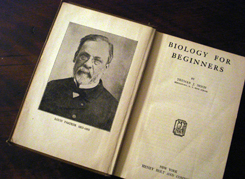May 15, 2009
 It’s a powerful symbol of capitulation: the straight on, serious portrait of Charles Darwin, the wizened, white bearded author of the Origin of Species and father of modern biology, was stripped from the frontispiece of a popular high school textbook, replaced by, of all things, a cartoon of the human digestive tract. According to New York Times writer Susan Jacoby, the insidious nature of the fundamentalist campaign to censor biology textbooks after the Scopes trial of 1925 is “literally illustrated” by this act. In 1921, Darwin was there. By 1926, he was gone. As were all mentions of his theory of evolution.
It’s a powerful symbol of capitulation: the straight on, serious portrait of Charles Darwin, the wizened, white bearded author of the Origin of Species and father of modern biology, was stripped from the frontispiece of a popular high school textbook, replaced by, of all things, a cartoon of the human digestive tract. According to New York Times writer Susan Jacoby, the insidious nature of the fundamentalist campaign to censor biology textbooks after the Scopes trial of 1925 is “literally illustrated” by this act. In 1921, Darwin was there. By 1926, he was gone. As were all mentions of his theory of evolution.
As with any myth, this one contains a few kernels of truth.
Yes, Darwin did grace the frontispiece of the 1921 edition of Truman J. Moon’s Biology for Beginners. Yes, his portrait was replaced in 1926 by a cartoon of the digestive tract. And yes, by the 1933 edition, the word evolution was gone, not to reappear until after a federally funded effort directed by the Biological Sciences Curriculum Study (BSCS) drove all publishers to modernize their texts in the 1960s.
But this story skips lightly over a few complicating facts.
 First, Moon replaced the portrait of Darwin with a portrait of Louis Pasteur (full text) in 1924, the year before Scopes. Second, Moon changed his text little between 1924 and editions and revisions published into the early 1930s. And third, though the word evolution did disappear from Moon’s textbook, the number of pages devoted to the subject – under the label “racial development” – actually grew considerably – from 17 pages in 1921, to 68 in 1933. Early scholarship, including Peter Miller’s 1966 honors thesis, “Darwin and the Textbooks,” and Judith Grabiner and Peter Miller’s 1974 article, “Effects of the Scopes Trial,” noted these nuances. However, in repeated retellings, the story has been simplified, and critical information has been lost.
First, Moon replaced the portrait of Darwin with a portrait of Louis Pasteur (full text) in 1924, the year before Scopes. Second, Moon changed his text little between 1924 and editions and revisions published into the early 1930s. And third, though the word evolution did disappear from Moon’s textbook, the number of pages devoted to the subject – under the label “racial development” – actually grew considerably – from 17 pages in 1921, to 68 in 1933. Early scholarship, including Peter Miller’s 1966 honors thesis, “Darwin and the Textbooks,” and Judith Grabiner and Peter Miller’s 1974 article, “Effects of the Scopes Trial,” noted these nuances. However, in repeated retellings, the story has been simplified, and critical information has been lost.

g5z39p
ek3h3c
7i6pey